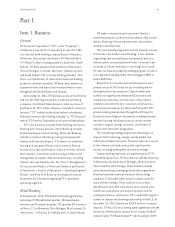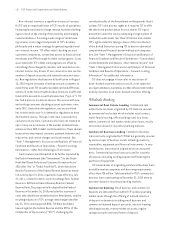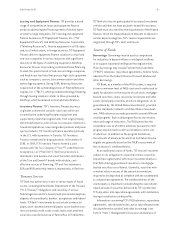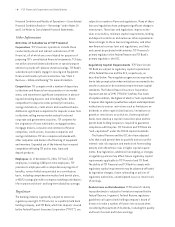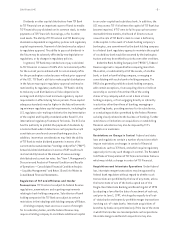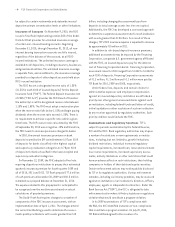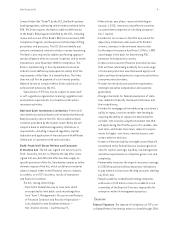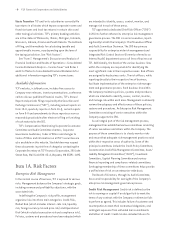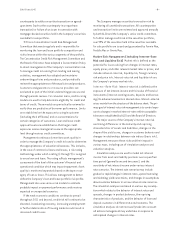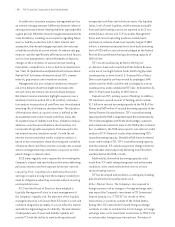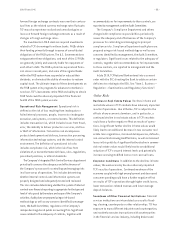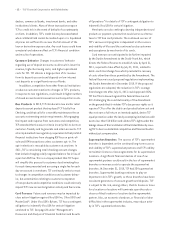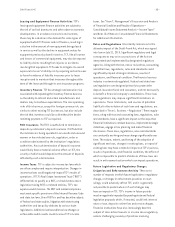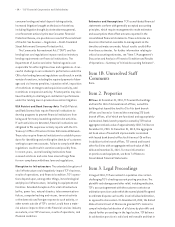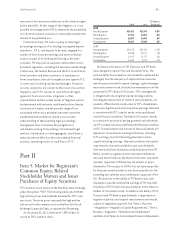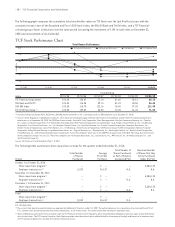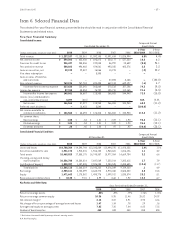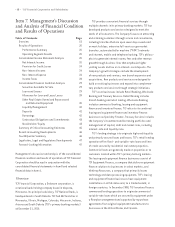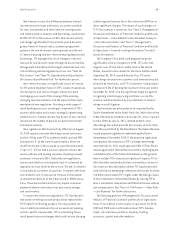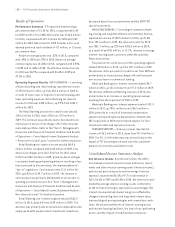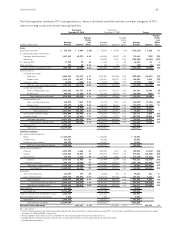TCF Bank 2010 Annual Report Download - page 27
Download and view the complete annual report
Please find page 27 of the 2010 TCF Bank annual report below. You can navigate through the pages in the report by either clicking on the pages listed below, or by using the keyword search tool below to find specific information within the annual report.• 11 •
2010 Form 10-K
forward foreign exchange contracts vary over their contrac-
tual lives as the related currency exchange rates fluctuate.
TCF may also experience realized and unrealized gains or
losses on forward foreign exchange contracts as a result of
changes in foreign exchange rates.
The investments in FHLB stock are required investments
related to TCF’s borrowings from these banks. FHLBs obtain
their funding primarily through issuance of consolidated
obligations of the FHLB system. The U.S. Government does
not guarantee these obligations, and each of the 12 FHLBs
are generally jointly and severally liable for repayment of
each other’s debt. The FHLB system has experienced finan-
cial stress in recent years, and some of the regional banks
within the FHLB system have suspended or reduced their
dividends, or eliminated the ability of members to redeem
capital stock. The ultimate impact of these developments on
the FHLB system or its programs for advances to members is
not clear. TCF’s investments in the FHLB and ability to obtain
FHLB funds could be adversely impacted if the financial
health of the FHLB system worsens.
Operational Risk Management Operational risk is
defined as the risk of loss resulting from inadequate or
failed internal processes, people, incorrect or inadequate
execution, and systems, or external events. This definition
includes transaction risk, which includes losses from fraud,
error, the inability to deliver products or services, and loss
or theft of information. Transaction risk encompasses
product development and delivery, transaction processing,
information technology systems, and the internal control
environment. The definition of operational risk also
includes compliance risk, which is the risk of loss from
violations of, or nonconformance with laws, rules, regulations,
prescribed practices, or ethical standards.
The Company’s Integrated Risk Control Services department
periodically assesses the adequacy and effectiveness of
the Company’s processes for controlling and managing risks
in all core areas of operations. This includes determining
whether internal controls and information systems are
properly designed and adequately tested and reviewed.
This also includes determining whether the system of internal
controls over financial reporting is appropriate for the type and
level of risks posed by the nature and scope of the Company’s
activities. Audit plans are prepared using a risk- based
methodology as well as any concerns identified by manage-
ment, the Audit Committee, regulators or the Company’s
independent registered public accounting firm. Significant
issues related to the adequacy of controls, together with
recommendations for improvements to those controls, are
reported to management and the Audit Committee.
The Company’s Compliance Department and others
charged with compliance responsibilities periodically
assess the adequacy and effectiveness of the Company’s
processes for controlling and managing its principal
compliance risks. Compliance Department audit plans are
prepared using a risk-based methodology as well as any
concerns identified by management, the Audit Committee,
or regulators. Significant issues related to the adequacy of
controls, together with recommendations for improvements
to those controls, are reported to management and the
Audit Committee.
In July 2010, TCF National Bank entered into a consent
order with the OCC directing the Bank to address certain
deficiencies relating to the BSA. See “Item 1. Business –
Regulation – Examinations and Regulatory Sanctions”.
Other Risks
Declines in Real Estate Values Declines in home and
real estate values in TCF’s markets have adversely impacted
results of operations. Like all banks, TCF is subject to the
effects of any economic downturn, and in particular, a
continued decline in real estate values in TCF’s markets
could have a further negative effect on results of opera-
tions. A significant further decline in home values would
likely lead to an additional decrease in new consumer real
estate loan originations, increased delinquencies, defaults,
non-accrual and accruing modified loans, as well as increased
losses in this portfolio. A significant further decline in commer-
cial real estate values would likely lead to an additional
reduction of TCF’s secured interest levels and potentially
increase accruing modified loans or non-accrual loans.
Economic Conditions In addition to the declines in home
values, the weak economy has also adversely impacted
TCF’s results of operations. Continued weakness of the
economy coupled with high unemployment and decreased
consumer spending could have a further negative effect
on results of TCF’s operations through higher credit losses,
lower transaction-related revenues and lower average
deposit balances.
Soundness of Other Financial Institutions Financial
services institutions are interrelated as a result of trad-
ing, clearing, counterparty or other relationships. TCF has
exposure to many different industries and counterparties,
and routinely executes transactions with counterparties
in the financial services industry, including brokers and


